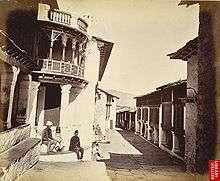Kumaon Kingdom

Kumaon Kingdom (Hindi: कुमाऊँ राज्य) was a Himalayan kingdom in the Kumaon region of present-day Uttarakhand state of India.
History
Ancient
The Kunindas was the first ruling dynasty of Kumaon and reigned from 500 BCE to CE 600.
From the 7th to the 11th century, the Katyuri kings ruled the Kumaon region and built the 900-year-old sun temple of Katarmal, on a hilltop facing east (opposite Almora).[1] Kartikeyapura (modern Baijnath) was the new capital and the Gomati Valley came to be known as the Katyur Valley after the ruling dynasty.[2]
Sometime in the 10th century, the Chand kingdom was established by Som Chand, who came from Kannuaj near Allahabad, and displaced the Katyuri Kings. He continued to call his state Kurmanchal, and established its capital in Champawat in Kali Kumaon. The Baleshwar and Nagnath temples were built in this former capital city during the 11th and 12th centuries.[3] From the 13th to 18th centuries, Kumaon prospered under the Chand monarchs who had their origins in the plains of India. During this period, learning and new forms of painting (the Pahari school of art) developed.[4] During 1591–1611
One of most powerful ruler of Chand dynasty was Baz Bahadur (1638–78) AD, who met Shahjahan in Delhi, and in 1655 joined forces with him to attack Garhwal, which was under its king, Pirthvi Shah, and subsequently captured the Terai region including Dehradun, which was hence separated from the Garhwal kingdom. Baz Bahadur extended his territory east to karnali river.
In 1672, Baz Bahadur, started a poll tax, and its revenue was sent to Delhi as a tribute. Baz Bahadur also built the Golu Devta Temple, at Ghorakhal, near Bhimtal, after Lord Golu, a general in his army, who died valiantly at war. He also built famous Bhimeshwara Mahadev Temple at Bhimtal. Towards the end of the 17th century, Chand Rajas again attacked Garhwal kingdom, and in 1688, Udyot Chand, erected several temples at Almora, including Tripur Sundari, Udyot Chandeshwar and Parbateshwar, to mark his victory over Garhwal and Doti, the Parbateshwar temple was renamed twice, to become the present Nanda Devi temple.[2] Gyan Chand, the king of kumaun ascended the throne in 1698. In 1699 he attacked Garhwal, which was under the king Fateh Shah. He crossed Ramganga river and plundered Sabli, Khatli, and Sainchar. In 1701, Fateh shah entered in Chaukote (now Syalde region with 3 part, Talla Chaukote (lower), Malla Chaukote (Upper) and Bichla Chaukote (middle)) and Gewar vally (region of Chaukhutiya, Masi and Dwarahat) as reply. The Kumaonis defeated the Garhwalis in the battle of Duduli (near Melchauri in Garhwal). In 1707, the Kumaon forces annexed Juniyagarh in Bichla Chaukot (syalde), and razed the old fort at Chandpur. Later, Jagat Chand (1708–20), defeated the Raja of Garhwal and pushed him away from Srinagar, and his kingdom was given to a Brahmin. However, a subsequent king of Garhwal, Pradip Shah (1717–72), regained control over Garhwal and retained Doon till 1757, when Rohilla leader, Najib-ud-Daula, established himself there, though he was ousted soon by Pradip Shah.
Kumaon Province

In 1791, the Gorkhas of Nepal expanding their nascent kingdom westwards across Kali River into what is now India, invaded and overran Almora, the seat of the Kumaon Kingdom and other parts of the kingdom. The Gorkhas were defeated by the East India Company in Anglo-Nepalese War and were forced to cede Kumaon to the British as part of the Treaty of Sugauli in 1816. The Kumaon region was joined with the eastern half of the Garhwal region and was governed as a chief-commissionership, also known as the Kumaon Province, on the non-regulation system.[5] In seventy years it was governed by three successive administrators: Mr. Traill, Mr J. H. Batten and Sir Henry Ramsay. The British set up a small administrative unit to govern the region, known as Patwari Halka.[6]
Kumaoni culture
Kumaoni people
Kumauni or Kumaoni are people from the Kumaon region of Uttarakhand, India living in the eight districts of Almora, Bageshwar, Champawat, Pithoragarh, Nainital, Dehradun, Udham Singh Nagar and Pauri.
Kumaoni language
The Kumaoni language (कुमाँऊनी भाषा (Devanagari)) is one of the Central Pahari languages. For a number of reasons, Kumaoni usage is shrinking rapidly. UNESCO’s Atlas of the World's Languages in Danger designates Kumaoni as a language in the unsafe category which requires consistent conservation efforts.[7]
References
- ↑ History of Kumaon
- ↑ Omacanda Hāṇḍā (2002). History of Uttaranchal. Indus Publishing. pp. 72–. ISBN 978-81-7387-134-4. Retrieved 22 July 2012.
- ↑ History Of Kumaon - Brahmins From Kumaon Hills
- ↑ Pande, B. D. (1993). History of Kumaun: English version of "Kumaun ka itihas". Almora, U.P., India: Shyam Prakashan: Shree Almora Book Depot.
- ↑ Robert Montgomery Martin, History of the Possessions of the Honourable East India Company, Volume 1, pg. 107
- ↑ Brief History of the Kumaon Regiment from official site of the Indian Army
- ↑ "UNESCO Interactive Atlas of the World's Languages in Danger". UNESCO. Retrieved 3 September 2010.